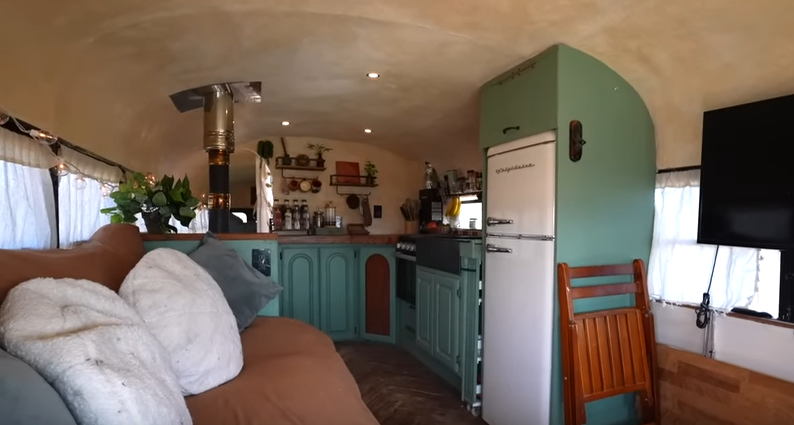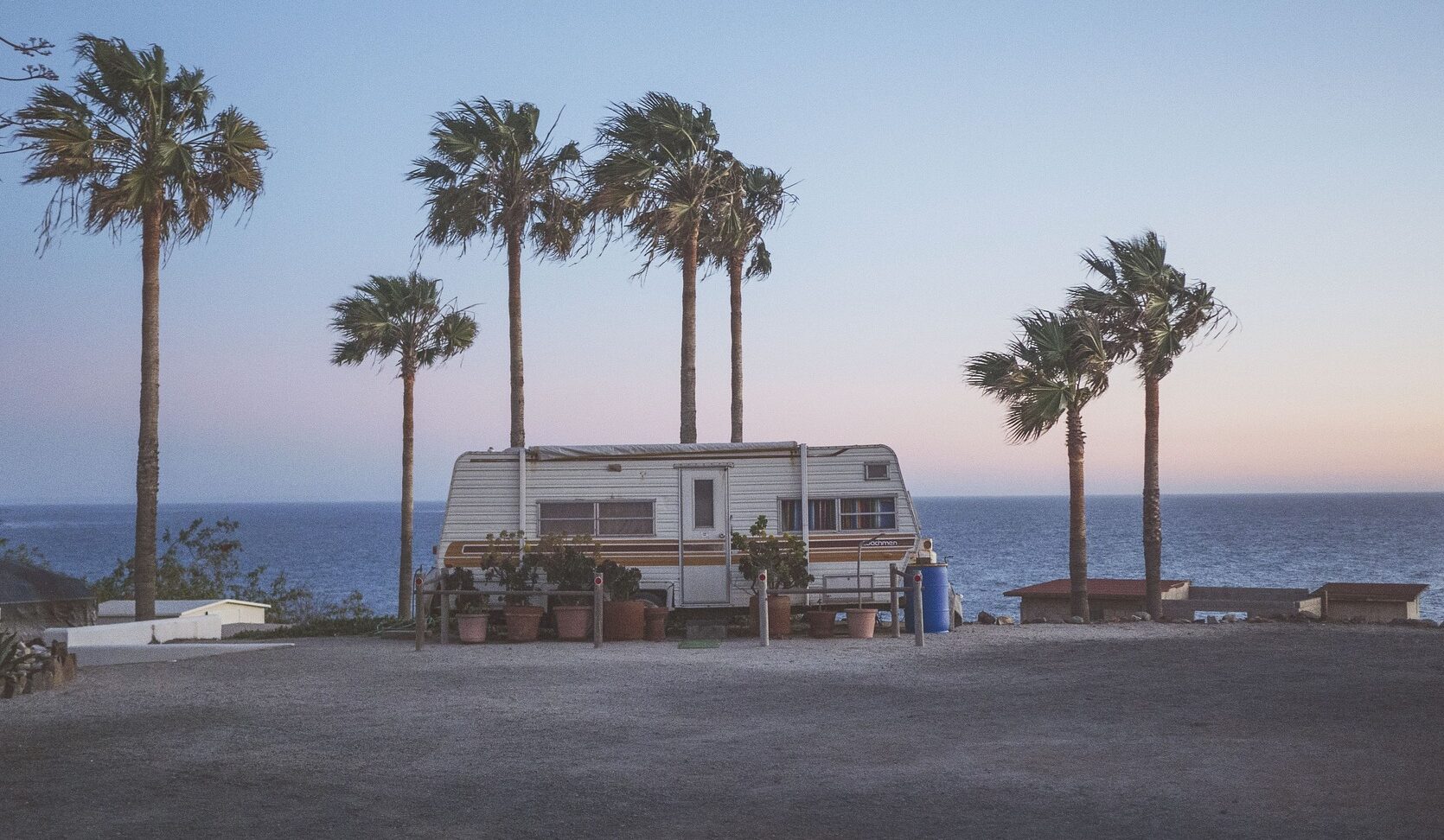Like the idea of hitting the open road, but have kids? A school bus is likely your answer. I’ve seen as many as 5 people living in a school bus full-time. The kids were all homeschooled and their travels all across the U.S. were part of their education. (If you don’t feel qualified to teach your children, or you and your spouse both need to work, there are online school options that completely replace the standard in-person curriculum, or you can just have your kids take certain classes online if, say, you’re terrible at math but can do everything else.) If you worry about your kids not being socialized, check out nomad caravans and see if you can get in with a group that is family-centered, or at least has several families in it. If you’re going to be in one area for a little while, you can also check out homeschool groups that meet up for field trips, play dates, and the like. Online schools may also offer time when the kids are allowed to talk to one another outside of class time, allowing them to have consistent contact with others their age. And the nice thing about being mobile is you can always take your kids to visit their online friends in real life periodically, regardless of where they might live.
If something the size of a school bus is a bit intimidating to drive, or you’re a single person and just don’t need that much space, consider this smaller shuttle bus. This build might also be inspiring if you think you can’t be a nomad because you’re not neat or minimalist by nature. This owner is an artist and has a very boho bus that’s as cluttered and random as an attic. The bus with renovations (which includes a lot of recycled materials) was $9,000, making even something this size well within the reach of most people financially:
This boho short school bus is home to a young single woman and two cats. You’re not likely to feel claustrophobic in this vehicle; there’s plenty of space for one or two people. She works remotely and primarily uses Starlink for her internet connection while traveling. The bus and build-out, including having someone else do some of the buildout and solar install, cost about $45,000. This sounds pricey until you realize that’s what a new, mid-size SUV is going for in 2023. So for the price of a good-sized car, you can have an even bigger vehicle and a place to live in.
This short bus is home to a widowed woman and her 6 year old son, who left everything behind when her husband died and hit the open road. She had the bus custom-built, but it has a simple enough design. One unique feature is her son’s bunk bed, which runs across the foot of her bed. Two adults are going to want more privacy, but this is a space-saving option for a single adult with a child.
This vintage school bus is home to a family of three and has plenty of living space and all the amenities (they do get the shower finished in another video).
This school bus doesn’t have anything particularly unique about it, but the owner makes some good points in his video. One, prioritize what’s important to you. As a professional chef, cooking is important to him, so he created a larger kitchen with larger appliances and fixtures than you see in many tiny homes. Also, he wanted a place to nap, so a couch was more important to him than extra chairs or a bigger table. Everything else that was a lower priority was filled in around these wants. The other thing he pointed out was that if he chooses to get a house later, he can park the bus and rent it out as an AirBnB. Depending on how popular his location is, his rental could pay for most or all of his mortgage:
This unique school bus is home to a nomadic couple. The husband works remotely as an architect while the wife is a professional photographer. What makes their bus unique is that they did the inside in adobe, so it looks like the houses they grew up in and around in New Mexico. You would think that adobe would not work in a structure that will flex, but they have been living and traveling in their bus for 8 months and the ceiling hasn’t fallen off, so obviously it must work. The benefit to adobe is that it makes it a lot easier to do the ceiling and to fit walls into the curved ceiling, especially if you are not the best woodworker.
Despite the title, this is definitely not amateurs doing this building; they know what they’re doing. But, as they pointed out, they started somewhere, and that somewhere was watching other people’s YouTube videos on the process. They have started a paid forum and do consultations for other people building out buses, so if there’s some aspect of a project like this which feels beyond your ability, it would probably be money well spent to sign up for this forum, even if for just a month, and get your questions answered as you go through the toughest part of the build.
The build out:
Something noted in this video that I had not seen mentioned before is that they painted the top of the bus white to reflect sunlight. If you’re going to be in a cold climate most of the time, a dark vehicle would help you make the most of the suns rays, but as most people are going to be in warmer places—and considering it’s usually more expensive to try to stay cool—a light-colored vehicle (or just the roof) will help.
Also note the tool they’re using at the 10:24 to mark the curvature of the roof. That would make life a lot easier when dealing with curved roofs or even the curved sides in some vans.
The tour of the finished bus:
This build is by amateur builders. They saved a lot of time and money by doing things like just painting the ceiling instead of trying to install one, and they left all the windows, rather than covering them up or taking them out. Their cabinets are also regular kitchen cabinets, not custom-built (a good money-saver is to buy some used on Craigslist or from the Habitat ReStore). Furniture in the bedroom looks to be IKEA pieces rather than custom built as well (although their living room couches that have storage and turn into a second bed are custom).
This school bus holds a family of 5 full-time. There are bunkbeds for the kids, a small area for them to play indoors, a master bedroom with a queen-size bed for the parents, a sectional-style sofa and collapsible dining table that will seat all of them, a dry bath, and a good-sized kitchen. I think the only thing I would do differently, since they have an exterior door in the bathroom, is put fold-down RV stairs at that door so it’s quick and easy to nip into the potty without dragging your wet or dirty self through half the bus.
Some people have said that it’s terribly cruel to raise three kids in such a tiny space–as if separate bedrooms for each child is a historical norm. My mother grew up in the 60’s and 70’s in a family of 5 in a three-bedroom house. She not only shared a room with her sister, but they had to share a bed as well. A former coworker said that when her family moved from Puerto Rico to NYC in the 70’s, their family of ten lived in a two-bedroom apartment. She and three sisters shared a sleeper sofa. Throughout history, people have made tiny spaces work.
One family of four who sold their house and moved into a tiny house on wheels the size of a tractor trailer said that they actually liked living in a smaller space because it made them feel more like a family. Before, they had all been off in their own rooms doing their own thing most of the time, but now, the kids spend more time outside playing, and when indoors, everyone typically does activities together. The children said they missed a few things about having more space and privacy, but all-in-all, they did not want to go back to the way things were. Being together brought them more happiness than having more space to be alone. (This is consistent with what researchers have found: human interaction is the number one thing necessary for happiness and overall life satisfaction.)
This is a long tour of one couple’s skoolie. They cover some mistakes they make and things they would do differently, which can be helpful. He mentions at one point going with laminate flooring because it was cheaper, but it bubbles up and peels if it gets wet. I have laminate flooring in my house and this absolutely happens. Doggie accidents, spills, leaks, condensation, and tracking water or snow in from outside can happen at any time, and if you don’t see it and mop it up immediately, it will ruin your floor. So don’t make his mistake; go with linoleum or vinyl plank flooring.
My mother is staying in a camper right now as she is trying to sell her house and move closer to me. And she’s having a terrible issue with condensation. Skoolies with most of the windows left in and the roof left bare are going to have an issue with this as well because there’s not enough insulation to protect the warm inside from the cold outside. Gas heat seems to make this worse; a wood stove or electric heat, if you’re on grid, should help reduce this problem, as will dehumidifiers and vents/open windows. But, still, when designing your tiny house on wheels, think about moisture inside your vehicle and do not go with laminate floors or cabinets because the higher humidity and beads of condensation will peel the paper off the plywood. Use moisture-resistant paint or a sealing stain on all wood (including backs and interiors and places you don’t see). Think more like having a boat than a vehicle; it will save you headaches later.
Are you interested in a commercial vehicle as a potential home, but don’t need the space of a bus, or are afraid to drive one? Check out these other options: Adapting Commercial Vehicles for Affordable Long-Term Living
Want to be nomadic, but don’t want to buy a commercial vehicle? Check out: On the Road Again – Exploring Nomadic Housing Options


